
Although it may seem surprising, the truth is that the The Spanish Armada has had one of its most fertile nurseries inland, in the territory of the ancient kingdoms of Castilla y León. As often happens in this forgetful country, which ostracizes its great men, even its most famous heroes, most of them have fallen into the clutches of absolute oblivion. This is the case of a sailor and soldier from Bejarano, Tomás Olleros Mansilla . The trace of him would have disappeared forever in the mists of history, were it not for the heartfelt biography written by a descendant, the lawyer Manuel Olleros. A work almost impossible to find, since it is a non-sale edition of only one hundred and fifty copies, which compiles personal documents and the memories that still survived among his relatives.
Born in Béjar on August 14, 1838, there was nothing to suspect that he could follow a defeat, to use the nautical term, that would take him so far from his land. And even less so that he did it so early as decisively. Among his ancestors were lawyers, public or industrial notaries, like his father, owner of an important textile factory and who became a liberal deputy in the Cortes. No one among the Olleros, an influential family with no ties to shipping or the military, could explain the origin of little Tomás' seafaring vocation. What is certain is that the dreams of that child rose far above the thick foliage of the Sierra de Béjar, in whose lap he grew up.
He was only ten years old when his father explained to Elizabeth II “that he has a son […] who he wishes to dedicate to a career in arms in the General Corps of the Navy , to which he shows particular fondness”. He begged at the same instance that they deign to grant him "the grace of a Navy applicant with the use of uniform and the option of a place in the Naval College for when he reaches the age." At fourteen, his blue dreams began to come true. He arrived in Cádiz to enter the Naval College of San Carlos and saw the sea for the first time. Then an adventure began, that of his life, whose reality would far exceed his childish fantasies.
Those who knew him describe him as serious, dark, thin, with penetrating and dreamy brown eyes. Endearing and human in his personal relationships, he was energetic, tough and uncompromising in matters of service, not tolerating the slightest indiscipline. Bold character, he always faced the dangers to which he was exposed, as something inevitable and everyday. And there were many. he traveled all over the world . At only twenty-five years old he was posted to the Philippines, from where he traveled to China for the first time. He fought pirates in the same seas where Emilio Salgari placed his immortal character Sandokan. He also carried out missions to rescue captives and military operations against the warlike "Moors" of those latitudes. He also had to deal with the filibusters of the Caribbean, since he was assigned in different periods of his life to the Spanish Antilles. Aboard the corvette Tornado, he participated in the pursuit of the Hornet filibuster steamer that took refuge in Port au Prince (Haiti) where it was blocked.
His participation in a multitude of missions and feats of arms far from the Peninsula was notable, but it would be on the site of old Hispania where he earned the highest decoration, the Cross of San Fernando . At that time, Spain had worked a miracle that was difficult to overcome:she was immersed, simultaneously, in three wars. And all of them civilians! To the Ten Years War, started in Cuba in 1868, the Third Carlist War would be added in 1872 and the cantonal rebellion the following year, a few months after the First Republic was proclaimed. In this regard, apart from the independent canton of Cartagena, the best known, many others were proclaimed throughout the national geography, including that of Béjar, the birthplace of Tomás Olleros.
Tomás Olleros in the Third Carlist War
With the monarchy abolished, Spain had a new king:chaos. Very soon, the tensions between the most intransigent federalists would end with the resignation of the first president of the Republic, Estanislao Figueras . He is credited with a phrase, pronounced in his vernacular during the Council of Ministers, shortly before resigning, and which could not be more eloquent:“Senyors, I can't take it anymore. Vaig a ser-los franc:estic fins als collons de tots nosaltres!” ("Gentlemen, I can't take it anymore. I'm going to be frank:I'm fed up with all of us!").
The Carlist war was getting complicated and the services of Tomás Olleros, recently returned from Cuba, were needed. The army of Carlos VII closed the fence over Bilbao; the situation was very compromised. That is why he was assigned to the Cantabrian fleet where, commanding the schooner Buenaventura, he showed signs of heroism. His courage and leadership skills were essential to gain vital time and delay the sea blockade of the Biscayan capital. Portugalete, a strategic town at the mouth of the estuary, had suffered from the Carlist siege since the summer. Olleros assumed command of the schooner Buenaventura on December 19, 1873, "a position of maximum danger", as his biographer Manuel Olleros described it. Moored to the jetty, she would miraculously hold out for weeks, subjected to constant artillery and rifle fire from enemy positions.
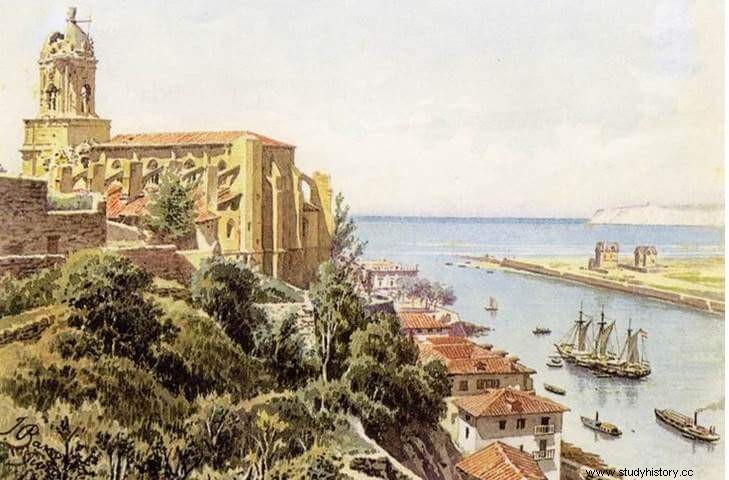
The Bonaventure , thanks to its three cannons mounted on colisas (rotating platforms), kept the besiegers at bay, dismantling the enemy batteries over and over again. Her troop landed on numerous occasions to carry out coups, such as the burning of the Casa Urquizu, which was in the hands of the Carlists. The personal diary of Tomás Olleros goes on detailing battles and casualties, humanizing the barbarism of war by giving names and surnames to those who would never leave it. Thus, on December 31, one could read:“Sailor Santiago Gorrilla was killed by a bullet to the head. The stern gun is disabled after having fired 448 shots”. Or on January 8, with six wounded, in which he writes:"Sailor M. Olavarrieta has died from a bullet to the head."
Only the tenacity of the Bejarano sailor, also wounded by a piece of bullet in the knee, made it possible to resist until January 11. For this, he would be awarded the 1st Class Cross of the Military Order of San Fernando. According to the contradictory file for its concession, that day the Buenaventura found itself with thirty-two bullets in its hull, “with nineteen casualties among its crew, taking on water and in imminent danger due to the special circumstances of the estuary that its ship fell into the power of the enemy or sank…” Faced with the rage and desperation of the Carlists, who already believed him to be a sure prey, she saved the ship in extremis . A few days later, after half a year of siege, Portugalete fell.
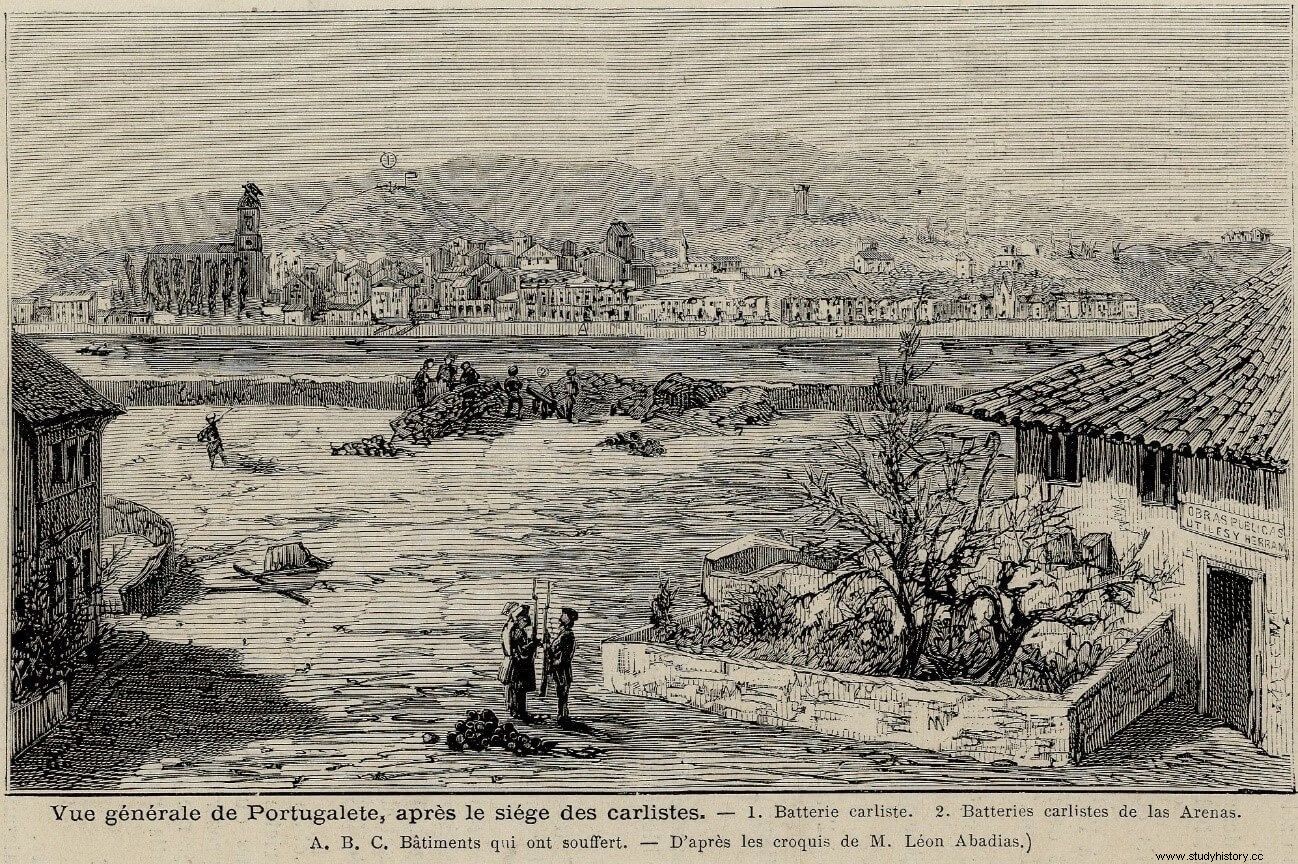
From Cuba to the East
There would be no rest for Tomás Olleros. Close to forty, he had finally found love, although he could not even attend his own wedding with Milagros Vernacci Moreau, from Cadiz, held by proxy on June 30, 1877. The previous year, after the last of the Carlist wars, He had to return to the island of Cuba where the spear of Mars had firmly embedded itself. There he will once again have the chance to prove himself. He accompanied General Martínez Campos and took him aboard on numerous occasions. , attached to his headquarters in military and political tasks. He fought both at sea and on land, commanding columns in today emblematic places such as Sierra Maestra, cradle of the Cuban Revolution eighty years later, and defeating the insurgents in different encounters. For all these reasons, he would achieve his promotion to Colonel of the Army and the Naval Merit Cross with a red badge.
Shortly after returning from Caribbean lands, in 1879, he would again be assigned to the distant seas of the East. Entrusted with a special mission, he would make a unique trip through China, Korea and Japan , as captain of the corvette María de Molina. He thus became one of the few Europeans who had visited cities like Beijing, Shanghai, Nagasaki or Yokohama. He would obtain for it a new Naval Merit Cross. Among other objectives, he had to arrive in Beijing to confer with the Spanish minister accredited there. He was decorated, "For the good sense and success with which he carried out the commission entrusted to him."
Some priceless memories, which he left written about this trip, offer endless data related to the culture, art, economy, geopolitics or customs of the countries that he visited. They show, on the other hand, the high cultural level, the cosmopolitanism and the sharpness in the judgments of its author. He refers to China as a true "living anthill" and recounts, as an anecdote, that, in the inns, the locals "crowded at the door admiring our faces", because for the vast majority it was the first time they had seen a European. . After speaking of the magnificent and luxurious buildings of the diplomatic missions of almost all the nations accredited there, he refers to the Spanish one:“Our minister and secretary lived closely together in an inn, the only one I think there is in Beijing, being the only legation that he has no house of his own. Now it's about doing it.”
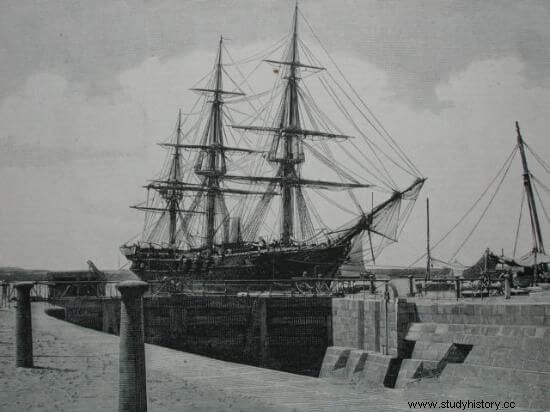
From that time is one of the most curious anecdotes of his biography, with his wife, Milagros Vernacci, as the main protagonist. She had accompanied him to the Philippines, and worried that several months had passed since her husband's departure for the mission in China, she decided to go look for him. For this, she did not hesitate to board a British ship that was sailing to the Chinese Empire, despite being the only woman on board and not understanding the language. It was then that one of the terrible storms so frequent in those seas was unleashed, to the point that her captain had to tie her tightly to one of the masts to safeguard her life.
The conquest of the Tawi-Tawi
Of the many missions he carried out throughout his life, there is one that stands out for its special meaning and importance:the conquest of the Tawi-Tawi group of islands. She thus became the protagonist of an event that, by itself, should have ensured her a place in the country's history. In a way, he could be called the ultimate conqueror. Figures such as that of the naval captain and infantry colonel Tomás Olleros help to understand how Spain was able to forge −and maintain for centuries− one of the largest empires in the world.
Those were the times of “hunting colonies, to which European nations show a determined fondness”, as could be read in a text from the time. And, although Spain had had rights to the Philippines for centuries, there was still some remote place that she had not formally taken possession of, so other powers could go ahead and claim it. That was the case of Tawi-Tawi, an archipelago near the island of Borneo, whose name, of Malay origin, means far away.
In addition to its eccentric position with respect to the main islands of the Philippines, there were other reasons why the red and white flag had not yet flown on them. The inhabitants of all those southern islands, such as Mindanao or Joló, the fearsome “Moorish” peoples (so called for being Muslim), were a constant source of concern and conflict for the Spanish authorities. Rebels and dedicated to piracy, Olleros had already participated in different actions against them years ago, when he was stationed for the first time in the Philippines.
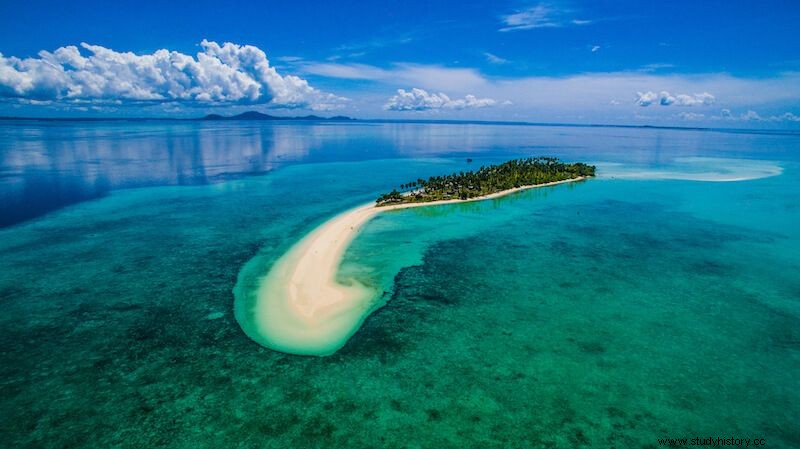
But, among all those southern islands, there was ones that had earned a special fame. A letter written from Zamboanga, in 1868, and addressed to the governor of Mindanao, contained a proposal on the repression of piracy in those seas. Some of his passages are certainly revealing. After indicating that very few Moorish people fail to take advantage of the occasion to engage in such infamous activity and negotiate with the unfortunate captives they have captured, he states the following:
Echoes of the cruelty of its indomitable inhabitants also reached the Peninsula. It was the year 1862 when in the Diario de Menorca, When giving an account of one of the military incursions carried out against their pirates, it could be read how the attackers "dared to penetrate the hidden and feared lair of the, even more cruel than the beasts, pirates of Tavi-Tavi", to then refer to “the horrible depredations that those barbarians had been carrying out on the inoffensive populations of the coasts of this archipelago, continually harassed by these bandits, who everywhere were sowing tears, despair and dishonor, seeming more like a cruel scourge of Providence, impossible to redeem, than made of men who could be held in check.”
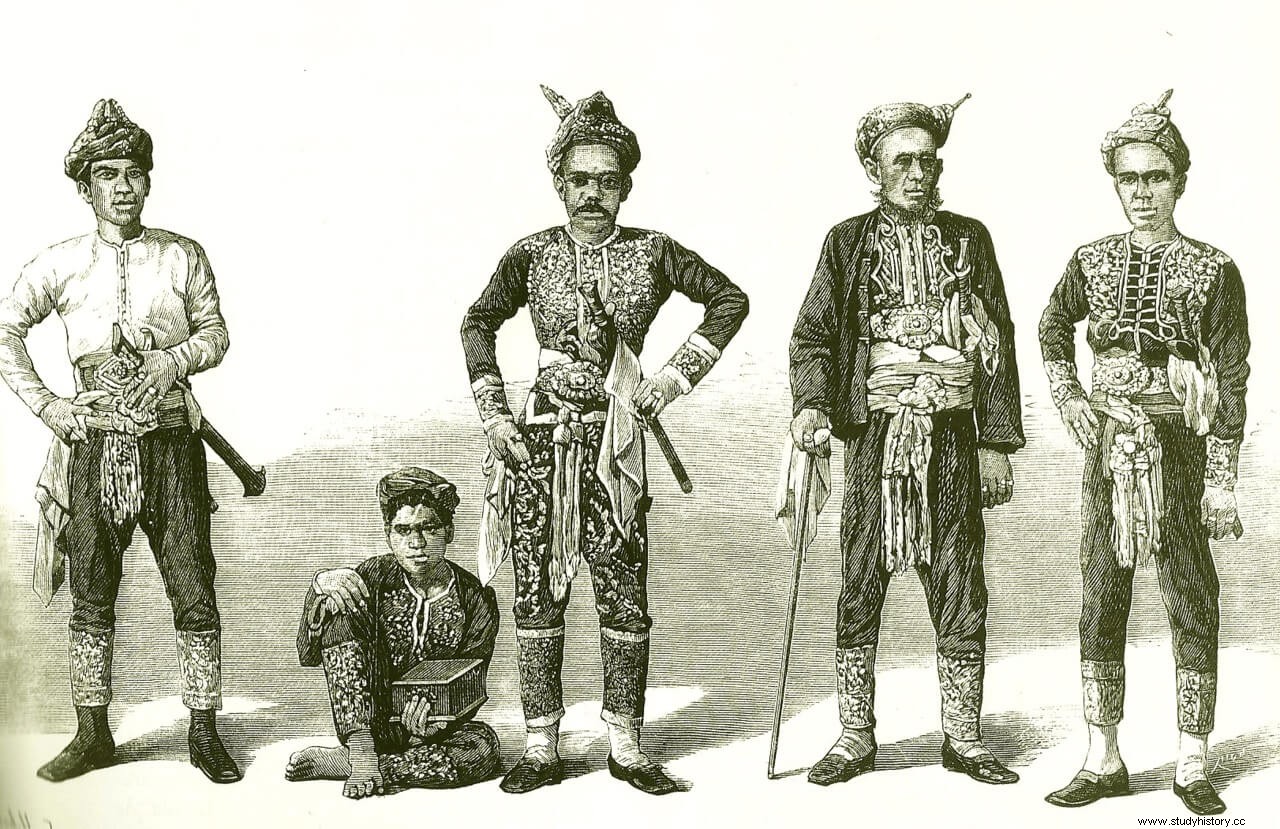
Besides the need to finish, once and for all for all, with that piratical focus, he urged the effective occupation of the territory. Both the United Kingdom and the German Empire had their sights set on Borneo – over which Spain also had rights – and also on the southernmost islands of the Philippines. The Madrid protocol, signed between Spain and these powers on March 11, 1877, had implicitly recognized Spanish sovereignty over the latter, but it was essential to take possession of them as soon as possible, since the matter was far from being closed.
Olleros would be in charge of commanding the expedition, which began at the end of January 1882, to conquer Tawi-Tawi , an archipelago, located between Joló and Borneo, with "more than forty islands, of which one is quite large, fourteen regular, and the rest small". To do this, he would have a corvette, a gunboat and marine infantry troops. Although with the usual delay with which the news arrived from that distant corner of Spain, on March 9 the chronicle sent in January by the Manila correspondent of La Correspondencia de España was published. . He spoke of rumors about the operations in the south of the archipelago and the concentration of forces in Joló. When he mentions one of the contingents that would be part of the expedition, he writes the following:
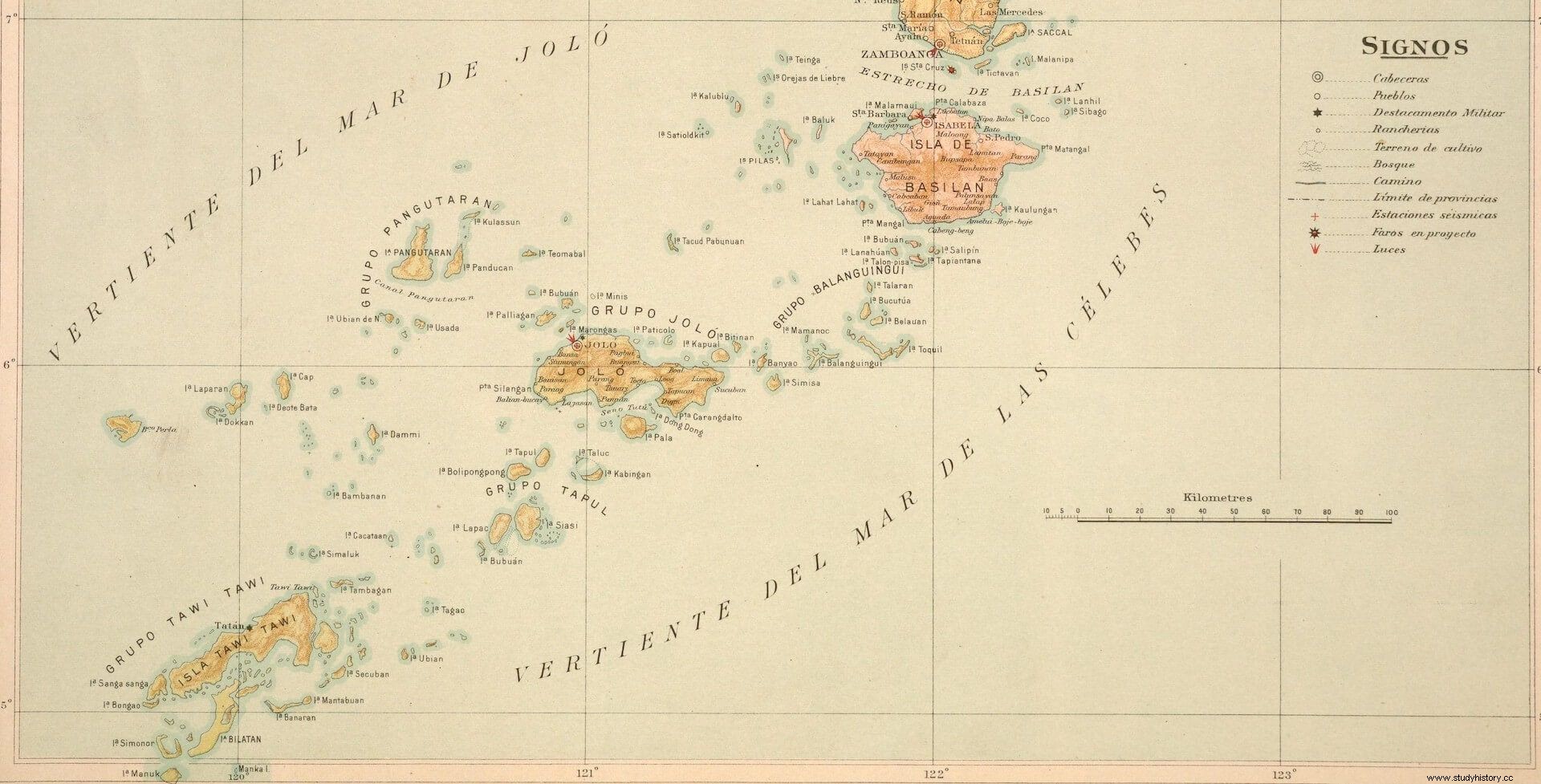
Actually, the same day these rumors were published in the Peninsula, Tomás Olleros completed his mission. According to the biography written by his great-nephew, "he built fortifications, established relations with the Moors of those rancherías and, after weeks of operations, on March 9, 1882, all the islands were under the Spanish flag." Some time before, the captain general of the Philippines had already announced that the operations had begun successfully:
This military occupation would allow the definitive recognition of Spanish sovereignty over Tawi-Tawi by these same powers, embodied in the protocol of March 7, 1885, signed in Madrid.
Return to the Peninsula
It would be precisely to this city that he would return from the Philippines, in 1886, to occupy an important position under the direct orders of the Minister of the Navy. He was the prototype of an illustrated sailor , of liberal ideas, and with extensive knowledge of languages and cultures −he published a Bisaya-Cebuana grammar in Manila and wrote several articles on geopolitical or naval issues−. All of this made him the best person to meet in person, during his visits to Spain, foreign leaders such as, to cite an example, Prince Arisugawa Takehito; the emperor of Japan would later send him, in gratitude for the services rendered, two magnificent bronzes adorned with the imperial arms.

Already on solid ground, he knew how to align with the same skill as in seas and oceans. After his arrival at the Villa and Court, he changed the command bridge of the warships for the offices of the Administration, in the very shadow of power. He was appointed, among other positions, 1st officer of the Ministry and in charge of personnel management, member of the commission to commemorate the fourth centenary of the Discovery of America, or secretary of the newly created Superior Council of the Navy.
There is no doubt that the personality of Tomás Olleros had an impact, as did his pet, a souvenir from the Philippines, a monkey tied to a collar with which he walked around the streets of Madrid. And he shared the intrepid character of his mistress:on one occasion he escaped through the Salamanca district. Shortly after, she was found besieged in a greengrocer "eating bananas and pelting all customers who had not fled in terror with eggs, oranges and other thrown fruits." The sailor arrived just before things escalated, reduced the exotic animal to obedience, generously compensated for the damage caused, and that became one of his funniest anecdotes.
Thus, the Bejarano sailor had the honor of having conquered what were, literally, the last territories of the empire on which the sun did not set. Although these are totally forgotten facts, in 1898 not everything was lost:the Tawi Tawi were still Spanish! An omission in the peace treaty with the US was to blame. Precisely, the same remoteness that caused it to be one of the last territories to be conquered by Spanish arms, caused it to be forgotten and to go unnoticed by the Americans.
Of course, the anomaly was discovered a short time later. The existence, in those latitudes, of lands that still remained under Spanish sovereignty caused a complicated situation and generated tension between both nations. On this occasion, weapons would not be the solution:on August 24, 1901, the Gaceta published the treaty by which the Tawi-Tawi islands were ceded to the Americans, in exchange for 100,000 dollars at the time.
However, Tomás Olleros was spared witnessing the sad end of the Empire in whose army he served. Only 52 years old and with a promising career ahead of him, in 1890 he died of infectious pneumonia. His funeral procession was headed by the Minister of the Navy, accompanied by numerous authorities and personalities, and forces from the Captaincy General of Madrid paid him honors by ordinance. He would never sail the dream seas of his childhood again.
Primary sources
- Diario de Menorca, dated November 18, 1862.
- The correspondence of Spain , of March 9 and June 24, 1882.
- The Gazette , dated August 24, 1901.
- VV.AA. (1889):Letters of the PP. of the Society of Jesus of the Philippine Mission . Manila:Type-lithography by Chofré y Compª.
Bibliography
- Ceballos-Escalera, A. Biographical Dictionary . Royal Academy of History.
- Montero, J. (1886):The Philippine Archipelago and the Mariana, Carolina and Palau Islands:their history, geography and statistics . Madrid:Imp. and foundry of Manuel Tello.
- Montero, J. (1888):History of Malayo-Mohammedan piracy in Mindanao, Joló and Borneo . Madrid:Imp. and foundry of Manuel Tello.
- Olleros, M. (1985):Tomás Olleros Mansilla, sailor and soldier from Bejarano (1838-1890) . Madrid:non-sale edition.
- VV.AA. (2019):Awake Ferro Contemporary #36:The Philippine War 1896-1898
